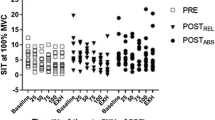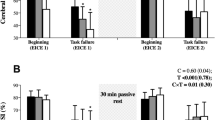Abstract
This study investigated the effects of acute hypoxia on spinal reflexes and soleus muscle function after a sustained contraction of the plantar flexors at 40 % of maximal voluntary isometric contraction (MVC). Fifteen males (age 25.3 ± 0.9 year) performed the fatigue task at two different inspired O2 fractions (FiO2 = 0.21/0.11) in a randomized and single-blind fashion. Before, at task failure and after 6, 12 and 18 min of passive recovery, the Hoffman-reflex (H max) and M-wave (M max) were recorded at rest and voluntary activation (VA), surface electromyogram (RMSmax), M-wave (M sup) and V-wave (V sup) were recorded during MVC. Normalized H-reflex (H max/M max) was significantly depressed pre-exercise in hypoxia compared with normoxia (0.31 ± 0.08 and 0.36 ± 0.08, respectively, P < 0.05). Hypoxia did not affect time to task failure (mean time of 453.9 ± 32.0 s) and MVC decrease at task failure (−18 % in normoxia vs. −16 % in hypoxia). At task failure, VA (−8 %), RMSmax/M sup (−11 %), H max/M max (−27 %) and V sup/M sup (−37 %) decreased (P < 0.05), but with no FiO2 effect. H max/M max restored significantly throughout recovery in hypoxia but not in normoxia, while V sup/M sup restored significantly during recovery in normoxia but not in hypoxia (P < 0.05). Collectively, these findings indicate that central adaptations resulting from sustained submaximal fatiguing contraction were not different in hypoxia and normoxia at task failure. However, the FiO2-induced differences in spinal loop properties pre-exercise and throughout recovery suggest possible specific mediation by the hypoxic-sensitive group III and IV muscle afferents, supraspinal regulation mechanisms being mainly involved in hypoxia while spinal ones may be predominant in normoxia.




Similar content being viewed by others
Abbreviations
- CNS:
-
Central nervous system
- DB100:
-
Resting doublet twitch torque at 100 Hz
- EMG:
-
Electromyography
- FiO2 :
-
Inspired oxygen fraction
- H max :
-
Hoffman reflex maximal peak-to-peak amplitude
- M max :
-
Resting M-wave maximal peak-to-peak amplitude
- M sup :
-
Superimposed M-wave maximal peak-to-peak amplitude
- MVC:
-
Maximal voluntary contraction
- R6:
-
Neuromuscular function testing after 6 min of passive recovery
- R12:
-
Neuromuscular function testing after 12 min of passive recovery
- R18:
-
Neuromuscular function testing after 18 min of passive recovery
- RMS:
-
Root mean square
- SOL:
-
Soleus muscle
- SpO2 :
-
Pulse arterial oxygen saturation
- TF:
-
Task failure
- VA:
-
Voluntary activation
- V sup :
-
Superimposed volitional-wave maximal peak-to-peak amplitude
References
Aagaard P, Simonsen EB, Andersen JL, Magnusson P, Dyhre-Poulsen P (2002) Neural adaptation to resistance training: changes in evoked V-wave and H-reflex responses. J Appl Physiol 92:2309–2318
Adam A, De Luca CJ (2005) Firing rates of motor units in human vastus lateralis muscle during fatiguing isometric contractions. J Appl Physiol 99:268–280
Amann M, Eldridge MW, Lovering AT, Stickland MK, Pegelow DF, Dempsey JA (2006) Arterial oxygenation influences central motor output and exercise performance via effects on peripheral locomotor muscle fatigue in humans. J Physiol 575:937–952
Amann M, Romer LM, Subudhi AW, Pegelow DF, Dempsey JA (2007) Severity of arterial hypoxemia affects the relative contributions of peripheral muscle fatigue to exercise performance. J Physiol 15:389–403
Arbogast S, Darques JL, Jammes Y (2002) Interactions between endogenous nitric oxide and hypoxemia in activation of group IV muscle afferents. Muscle Nerve 26:194–200
Barcroft H, Millen JL (1939) The blood flow through muscle during sustained contraction. J Physiol 97:17–31
Beliveau L, Helal JN, Gaillard E, Van Hoecke J, Atlan G, Bouissou P (1991) EMG spectral shift- and 31P-NMR-determined intracellular pH in fatigued human biceps brachii muscle. Neurology 41:1998–2001
Bigland-Ritchie B, Cafarelli E, Vollestad NK (1986a) Fatigue of submaximal static contractions. Acta Physiol Scand Suppl 556:137–148
Bigland-Ritchie BR, Dawson NJ, Johansson RS, Lippold OC (1986b) Reflex origin for the slowing of motoneurone firing rates in fatigue of human voluntary contractions. J Physiol 379:451–459
Caquelard F, Burnet H, Tagliarini F, Cauchy E, Richalet JP, Jammes Y (2000) Effects of prolonged hypobaric hypoxia on human skeletal muscle function and electromyographic events. Clin Sci (Lond) 98:329–337
Cater HL, Chandratheva A, Benham CD, Morrison B, Sundstrom LE (2003) Lactate and glucose as energy substrates during, and after, oxygen deprivation in rat hippocampal acute and cultured slices. J Neurochem 87:1381–1390
Cresswell AG, Löscher WN, Thorstensson A (1995) Influence of gastrocnemius muscle length on triceps surae torque development and electromyographic activity in man Exp Brain Res 105(2):283–290
Delliaux S, Jammes Y (2006) Effects of hypoxia on muscle response to tendon vibration in humans. Muscle Nerve 34:754–761
Dousset E, Decherchi P, Grelot L, Jammes Y (2001) Effects of chronic hypoxemia on the afferent nerve activities from skeletal muscle. Am J Respir Crit Care Med 164:1476–1480
Dousset E, Decherchi P, Grelot L, Jammes Y (2003) Comparison between the effects of chronic and acute hypoxemia on muscle afferent activities from the tibialis anterior muscle. Exp Brain Res 148:320–327
Duchateau J, Balestra C, Carpentier A, Hainaut K (2002) Reflex regulation during sustained and intermittent submaximal contractions in humans. J Physiol 541:959–967
Duclay J, Martin A (2005) Evoked H-reflex and V-wave responses during maximal isometric, concentric, and eccentric muscle contraction. J Neurophysiol 94:3555–3562
Fulco CS, Lewis SF, Frykman PN, Boushel R, Smith S, Harman EA, Cymerman A, Pandolf KB (1996) Muscle fatigue and exhaustion during dynamic leg exercise in normoxia and hypobaric hypoxia. J Appl Physiol 81:1891–1900
Gandevia SC (2001) Spinal and supraspinal factors in human muscle fatigue. Physiol Rev 81:1725–1789
Garland SJ (1991) Role of small diameter afferents in reflex inhibition during human muscle fatigue. J Physiol 435:547–558
Garland SJ, Gossen ER (2002) The muscular wisdom hypothesis in human muscle fatigue. Exerc Sport Sci Rev 30:45–49
Garland SJ, McComas AJ (1990) Reflex inhibition of human soleus muscle during fatigue. J Physiol 429:17–27
Garner SH, Sutton JR, Burse RL, McComas AJ, Cymerman A, Houston CS (1990) Operation Everest II: neuromuscular performance under conditions of extreme simulated altitude. J Appl Physiol 68:1167–1172
Gondin J, Duclay J, Martin A (2006) Soleus- and gastrocnemii-evoked V-wave responses increase after neuromuscular electrical stimulation training. J Neurophysiol 95:3328–3335
Goodall S, Ross EZ, Romer LM (2010) Effect of graded hypoxia on supraspinal contributions to fatigue with unilateral knee-extensor contractions. J Appl Physiol 109:1842–1851
Hong SS, Gibney GT, Esquilin M, Yu J, Xia Y (2004) Effect of protein kinases on lactate dehydrogenase activity in cortical neurons during hypoxia. Brain Res 1009:195–202
Hultborn H, Pierrot-Deseilligny E (1979) Changes in recurrent inhibition during voluntary soleus contractions in man studied by an H-reflex technique. J Physiol 297:229–251
Hultborn H, Illert M, Nielsen J, Paul A, Ballegaard M, Wiese H (1996) On the mechanism of the post-activation depression of the H-reflex in human subjects. Exp Brain Res 108:450–462
Johnson KV, Edwards SC, Van Tongeren C, Bawa P (2004) Properties of human motor units after prolonged activity at a constant firing rate. Exp Brain Res 154:479–487
Katayama K, Amann M, Pegelow DF, Jacques AJ, Dempsey JA (2007) Effect of arterial oxygenation on quadriceps fatigability during isolated muscle exercise. Am J Physiol Regul Integr Comp Physiol 292:R1279–R1286
Katayama K, Yoshitake Y, Watanabe K, Akima H, Ishida K (2010) Muscle deoxygenation during sustained and intermittent isometric exercise in hypoxia. Med Sci Sports Exerc 42:1269–1278
Kayser B, Bokenkamp R, Binzoni T (1993) Alpha-motoneuron excitability at high altitude. Eur J Appl Physiol Occup Physiol 66:1–4
Kuchinad RA, Ivanova TD, Garland SJ (2004) Modulation of motor unit discharge rate and H-reflex amplitude during submaximal fatigue of the human soleus muscle. Exp Brain Res 158:345–355
Lopez-Barneo J, Pardal R, Ortega-Saenz P (2001) Cellular mechanism of oxygen sensing. Annu Rev Physiol 63:259–287
Loscher WN, Cresswell AG, Thorstensson A (1996a) Central fatigue during a long-lasting submaximal contraction of the triceps surae. Exp Brain Res 108:305–314
Loscher WN, Cresswell AG, Thorstensson A (1996b) Excitatory drive to the alpha-motoneuron pool during a fatiguing submaximal contraction in man. J Physiol 491(Pt 1):271–280
Macefield G, Hagbarth KE, Gorman R, Gandevia SC, Burke D (1991) Decline in spindle support to alpha-motoneurones during sustained voluntary contractions. J Physiol 440:497–512
McNeil CJ, Giesebrecht S, Gandevia SC, Taylor JL (2011) Behaviour of the motoneurone pool in a fatiguing submaximal contraction. J Physiol 589:3533–3544
McNeil CJ, Butler JE, Taylor JL, Gandevia SC (2013) Testing the excitability of human motoneurons. Frontiers in human neuroscience 7:152
Merton PA (1954) Voluntary strength and fatigue. J Physiol 123:553–564
Misiaszek JE (2003) The H-reflex as a tool in neurophysiology: its limitations and uses in understanding nervous system function. Muscle Nerve 28:144–160
Neubauer JA, Sunderram J (2004) Oxygen-sensing neurons in the central nervous system. J Appl Physiol (1985) 96:367–374
Paasuke M, Rannama L, Ereline J, Gapeyeva H, Oopik V (2007) Changes in soleus motoneuron pool reflex excitability and surface EMG parameters during fatiguing low- vs. high-intensity isometric contractions. Electromyogr Clin Neurophysiol 47:341–350
Peltonen JE, Rusko HK, Rantamaki J, Sweins K, Niittymaki S, Viitasalo JT (1997) Effects of oxygen fraction in inspired air on force production and electromyogram activity during ergometer rowing. Eur J Appl Physiol Occup Physiol 76:495–503
Pensini M, Martin A (2004) Effect of voluntary contraction intensity on the H-reflex and V-wave responses. Neurosci Lett 367:369–374
Perrey S, Rupp T (2009) Altitude-induced changes in muscle contractile properties. High Alt Med Biol 10:175–182
Racinais S, Cresswell AG (2013) Temperature affects maximum H-reflex amplitude but not homosynaptic postactivation depression. Physiol Rep 1:e00019
Racinais S, Girard O, Micallef JP, Perrey S (2007) Failed excitability of spinal motoneurons induced by prolonged running exercise. J Neurophysiol 97:596–603
Racinais S, Maffiuletti NA, Girard O (2013) M-wave, H- and V-reflex recruitment curves during maximal voluntary contraction. J Clin Neurophysiol 30:415–421
Rudomin P, Schmidt RF (1999) Presynaptic inhibition in the vertebrate spinal cord revisited. Exp Brain Res 129:1–37
Rupp T, Perrey S (2009) Effect of severe hypoxia on prefrontal cortex and muscle oxygenation responses at rest and during exhaustive exercise. Adv Exp Med Biol 645:329–334
Schieppati M (1987) The Hoffmann reflex: a means of assessing spinal reflex excitability and its descending control in man. Prog Neurobiol 28:345–376
Stein RB (1995) Presynaptic inhibition in humans. Prog Neurobiol 47:533–544
Szubski C, Burtscher M, Loscher WN (2007) Neuromuscular fatigue during sustained contractions performed in short-term hypoxia. Med Sci Sports Exerc 39:948–954
Tanino Y, Daikuya S, Nishimori T, Takasaki K, Kanei K, Suzuki T (2004) H-reflex and reciprocal Ia inhibition after fatiguing isometric voluntary contraction in soleus muscle. Electromyogr Clin Neurophysiol 44:473–476
Taylor JL, Gandevia SC (2008) A comparison of central aspects of fatigue in submaximal and maximal voluntary contractions. J Appl Physiol 104:542–550
Taylor JL, Todd G, Gandevia SC (2006) Evidence for a supraspinal contribution to human muscle fatigue. Clin Exp Pharmacol Physiol 33:400–405
Upton AR, McComas AJ, Sica RE (1971) Potentiation of “late” responses evoked in muscles during effort. J Neurol Neurosurg Psychiatry 34:699–711
Verges S, Rupp T, Jubeau M, Wuyam B, Esteve F, Levy P, Perrey S, Millet GY (2012) Cerebral perturbations during exercise in hypoxia. Am J Physiol Regul Integr Comp Physiol 302:R903–R916
Willer JC, Miserocchi G, Gautier H (1987) Hypoxia and monosynaptic reflexes in humans. J Appl Physiol 63:639–645
Author information
Authors and Affiliations
Corresponding author
Additional information
Communicated by Nicolas Place.
Rights and permissions
About this article
Cite this article
Rupp, T., Racinais, S., Bringard, A. et al. Modulation of exercise-induced spinal loop properties in response to oxygen availability. Eur J Appl Physiol 115, 471–482 (2015). https://doi.org/10.1007/s00421-014-3032-5
Received:
Accepted:
Published:
Issue Date:
DOI: https://doi.org/10.1007/s00421-014-3032-5




